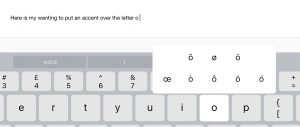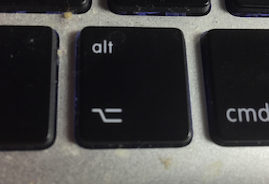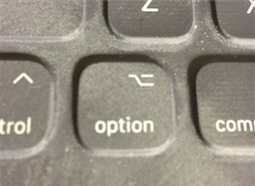It has got to that stage in my Spanish Language education where I have started to ask the question:
How do I type Spanish letters and accents?
Because I have a English keyboard on my Mac and on my iPad (the detachable one that is) I don’t have a key with an accent on it.
[Now if you are in the unfortunate position of not owning a MAC and have one of those other operating systems, the perhaps what you need can be found in this article here: How to type Spanish letters and accents (á, é, í, ó, ú, ü, ñ, ¿, ¡) on the Spanish Dictionary Website.]
I now find myself needing to start typing the accents and special characters as I branch out into other activities to learn how to speak and understand this fabulous language.
Now that I know how to do this, I shall just show off a bit… look what I can type…
á, é, í, ó, ú, ü, ñ, ¿, ¡
Of course I could have cheated and just copied and pasted from some other website.
However that would be cheating, so here is how to do it.
When I am using my iPhone or iPad on screen keyboard, it is quite simple because all I have to do is press and hold down the letter I want to type and a menu of options for that letter and the possible accents it might carry appears. All I have to do is select the one I want.
Unfortunately it is not so simple on a conventional “mechanical” keyboard.
So a quick google and this is how I discovered how to type an accented vowel or a tilde over an a,o or n.
In each case it refers to the Option key.
Now the symbol for this key looks like a cooking pan with a lid that’s been chopped in half right down the middle with the handle out to the left! I might have the world “alt” on it (like on my MacBookPro) or the word “option” on it (like on my iPadPro keyboard).
Typing an Accent – á, é, í, ó, ú
It is a two step process.
STEP 1 – Hold the Option Key AND the letter E at the same time. When you do this you will see an accent hang in mid air above the sentence, like this ´
STEP 2 – Now type the qualifying letter straight after (in Spanish this will be any of the vowels”) and the hanging accent will be placed over that letter like so á, é, í, ó, ú
Typing a tilde – ã, ñ, õ.
Again it is a two step process
STEP 1 – Hold the option key AND the letter N at the same time. When you do this the tilde will hang in mid air above the sentence like this ˜
STEP 2 – Now type the qualifying letter straight after (In Spanish this will be the letters, a, n and o) band the hanging tilde will be placed over the letter like so ã, ñ, õ.
For both of these, if you want the accent or tilde to appear over a capital letter, the same principle works, just when you type the letter either use SHIFT to capitalise it or use CAPSLOCK.
Typing an umlaut – ä, ö, ü
If I told you that the keys to use this are the option key AND the letter u, I bet by now you could tell me what to do to create the umlaut!!
Well you were right if you described the following two step process:
STEP 1 – Hold the option key and the letter U at the same time. When you do this the umlaut will hang in mid air above the sentence like this ¨
STEP 2 – now type the qualifying letter straight after (a, o or u) and the hanging umlaut will then be placed over your letter like so ä, ö, ü.
As with the other two, if you want it over a capital letter, simply use SHIFT or CAPSLOCK when you type the letter you want to have the umlaut on.
Typing an upside down question mark and upside down exclamation mark ¿ ¡
As above, a unique combination of keys is the secret to creating these unusual symbols. Well when I say unusual, they are unusual to native English speakers but of course are completely natural to Spanish speakers.
In fact I quite like the idea that right at the beginning of a sentence you know that it is going to be a question (or indeed an exclamation)
For the ¿
THE ONLY STEP – hold down the Option key and the SHIFT key at the same time as the normal ? Key
For the ¡
THE ONLY STEP – just hold down the Option key and the normal ! Key (which is usually the 1)










Leave A Response